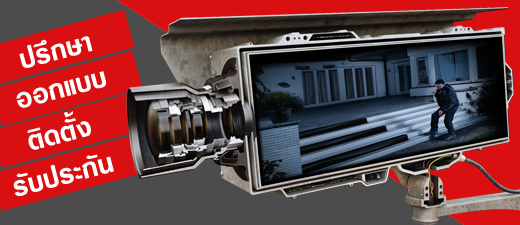หน้าแรก >> CCTV Surveillance
Video’s Critical Role in the Security Plan
1.4 VIDEO'S ROLE AND ITS APPLICATIONS
In its broadest sense, the purpose of CCIV in any secu rity plan is to provide remote eyes for a security operator: to create live-action displays from a distance. The video system should have recording means-either a VCR or a DVR, or other storage media-to maintain permanent records for training or evidence. Following are some appli cations for which video provides an effective solution:
• When overt visual observation of a scene or activity is required from a remote location.
• An area to be observed contains hazardous material or some action that may kill or injure personneL Such areas may have toxic chemicals, biological or radioactive mate rial, substances with high potential for fire or explosion, or items that may emit X-ray radiation or other nuclear radiation.
• Visual observation of a scene must be covert. It is much easier to hide a small camera and lens in a target loca tion than to station a person in the area.
• There is little activity to watch in an area, as in an intrusion-detection location or a storage room, but sig nificant events must be recorded in the area when they occur. Integration of video with alarm sensors and a time-lapse/real-time VCR or DVR provides an extremely powerful solution.
• Many locations must be observed simultaneously by one person from a central security location.
• Tracing a person or vehicle from an entrance into a facility to a final destination. The security force can pre dict where the person or vehicle can be interdicted.
• Often a guard or security officer must only review a scene for activity periodically. The use of video elimi nates the need for a guard to make rounds to remote locations, which is wasteful of the guard's time.
• When a crime has been committed, capturing the scene using the video camera and recorder to have a perma nent record and hard copy printout of the activity and event. The proliferation of high-quality printed images from VCR;DVR equipment has clearly made the case for using video for creating permanent records.
1.4.1 Video System Solutions
The most effective way to determine that a theft has occurred, when, where, and by whom, is to use video for detection and recording. The particular event can be identified, stored, and later reproduced for display or hard copy. Personnel can be identified on monochrome or color CCTV monitors. Most security installations use color CCTV cameras that provide sufficient information to document the activity and event or identify personnel or articles. The color camera permits easier identification of personnel and objects.
Ifthere is an emergency or disaster and security personnel must see ifpersonnel are in a particular area, video can provide an instantaneous assessment of personnel location and availability.
In many cases during normal operations, security per sonnel can help ensure the safety of personnel in a facility, determine that employees or visitors have not entered the facility, or confirm that personnel have exited the facil ity. Such functions are used for example where dangerous jobs are performed or hazardous material is handled.
The synergistic combination of audio and video infor mation from a remote site provides for effective secu rity. Several camera manufacturers and installers combine video and audio (on way or duplex) using an exter nal microphone or one installed directly in the camera. The video and audio signals are transmitted over the same coaxial, unshielded-twisted-pair (UTP), or fiber-optic cable, to the security monitoring location where the scene is viewed live and/or recorded. When there is activity in the camera area the video and audio signals are switched to the monitor and the guard sees and hears the activity in the scene and initiates a response.
1.4.2 Overt vs. Covert Video
Most video installations use both overt and covert (hid den) CCIV cameras, with more cameras overt than covert. Overt installations are designed to deter crime and pro vide general surveillance of remote areas such as parking lots, perimeter fence lines, warehouses, entrance lobbies, hallways, or production areas. When CClV cameras and lenses are exposed, all managers, employees, and visitors realize that the premises are under constant video surveil lance. When the need arises, covert installations are used to detect and observe clandestine activity. While overt video equipment is often large and not meant to be con cealed, covert equipment is usually small and designed to be hidden in objects in the environment or behind a ceiling or wall. Overt cameras are usually installed per manently whereas covert cameras are usually designed to be installed quickly, left in place for a few hours, days, or weeks, and then removed. Since minimizing installa tion time is desirable when installing covert cameras, video signal transmission often is wireless rather than wired.
1.4.2 Overt vs. Covert Video
Most video installations use both overt and covert (hid den) CCIV cameras, with more cameras overt than covert. Overt installations are designed to deter crime and pro vide general surveillance of remote areas such as parking lots, perimeter fence lines, warehouses, entrance lobbies, hallways, or production areas. When CClV cameras and lenses are exposed, all managers, employees, and visitors realize that the premises are under constant video surveil lance. When the need arises, covert installations are used to detect and observe clandestine activity. While overt video equipment is often large and not meant to be con cealed, covert equipment is usually small and designed to be hidden in objects in the environment or behind a ceiling or wall. Overt cameras are usually installed per manently whereas covert cameras are usually designed to be installed quickly, left in place for a few hours, days, or weeks, and then removed. Since minimizing installa tion time is desirable when installing covert cameras, video signal transmission often is wireless rather than wired.
1.4.3 Security Surveillance Applications
Many video applications fall broadly into two types, indoor and outdoor. This division sets a natural boundary between equipment types: those suitable for controlled indoor environments and those suitable for harsher out door environments. The two primary parameters are envi ronmental factors and lighting factors. The indoor system requires artificial lighting that may or may not be aug mented by daylight. The indoor system is subject to only mild indoor temperature and humidity variations, dirt, dust, and smoke. The outdoor system must with stand extreme temperatures, precipitation (fog, rain, and snow), wind, dirt, dust, sand, salt, and smoke. The out door systems use natural daylight and artificial lighting at night supplied either by parking lights or by a co located infrared (IR) source. Some cameras can auto matically switch from color operation during daylight, to monochrome when the lighting decreases below some specified level for nighttime operation.
Most video security applications use fixed, permanently installed video equipment. These systems are installed for months and years and left in place until they are super seded by new equipment or they are no longer required. There are many cases, however, where there is a requir ment for a rapid deployment of video equipment to be used for a short period of time: days, weeks, or sometimes months, and then removed to be used again in another application. Chapter 21 describes some of these trans portable rapid deployment video systems.
1.4.4 Safety Applications
In public, government, industrial, and other facilities, a safety, security, and personnel protection plan must guard personnel from harm caused by accident, human error, sabotage, or terrorism. Security forces are expected to monitor the conditions and activities at all locations in the facility through the use of CClV cameras.
In a hospital room or hallway the video cameras may serve a dual function: monitoring patients while also deter mining the status and location of employees, visitors, and others. A guard can watch entrance and exit doors, hall ways, operating rooms, drug dispensaries, and other vital areas.
Safety personnel can use video for evacuation and to determine if all personnel have left the area and are safe. Security personnel can use video for remote traffic mon itoring and control and to ascertain high-traffic locations and how best to control them. Video plays a critical role in public safety, as a tool for monitoring vehicular traffic on highways and city streets, in truck and bus depots, at public rail and subway facilities, airports, power plants, just to name a few.
1.4.5 Video Access Control
As security requirements become more complex and demanding, video access control and electronic access control equipments should work synergistically with each other. For medium- to low-level access control secu rity requirements, electronic card-reading systems are adequate after a person has frrst been identified at some exterior perimeter location. For higher security, personal biometric descriptors (iris scanning, fingerprint, etc.) and/or video identification are necessary.
Video smveillance is often used with electronic or video access control equipment. Video access control uses video to identify a person requesting access at a remote loca tion, on foot or in a vehicle. A guard can compare the live image and the photo ID carried by the person on a video monitor and then either allow or deny entry. For the highest level of access control security the guard uses a system to compare the live image of the person to an image of the person retrieved from a video image database or one stored in a smart card. The two images are dis played side by side on a split-'Screen monitor along with other pertinent information. The video access control sys tem can be combined with an electronic access control system to increase security and provide a means to track all attempted entries.
There are several biometric video access control systems which can positively identify a person enrolled in the system using iris, facial, or retina identification.
















